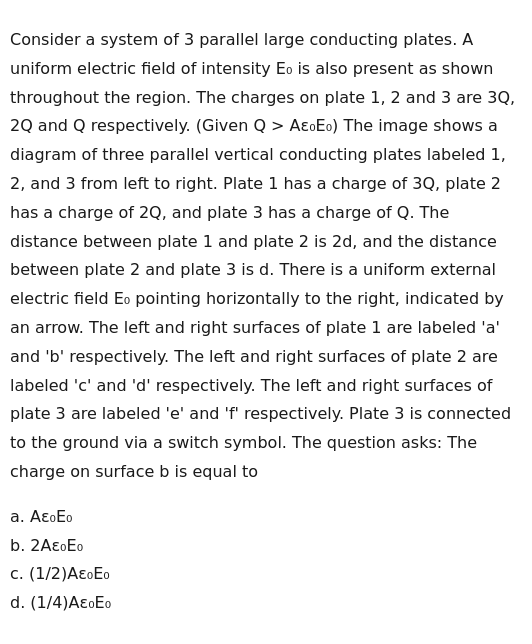Question
Question: Consider a system of 3 parallel large conducting plates. A uniform electric field of intensity E₀ is...
Consider a system of 3 parallel large conducting plates. A uniform electric field of intensity E₀ is also present as shown throughout the region. The charges on plate 1, 2 and 3 are 3Q, 2Q and Q respectively. (Given Q > Aε₀E₀) The image shows a diagram of three parallel vertical conducting plates labeled 1, 2, and 3 from left to right. Plate 1 has a charge of 3Q, plate 2 has a charge of 2Q, and plate 3 has a charge of Q. The distance between plate 1 and plate 2 is 2d, and the distance between plate 2 and plate 3 is d. There is a uniform external electric field E₀ pointing horizontally to the right, indicated by an arrow. The left and right surfaces of plate 1 are labeled 'a' and 'b' respectively. The left and right surfaces of plate 2 are labeled 'c' and 'd' respectively. The left and right surfaces of plate 3 are labeled 'e' and 'f' respectively. Plate 3 is connected to the ground via a switch symbol. The question asks: The charge on surface b is equal to

Aε₀E₀
2Aε₀E₀
(1/2)Aε₀E₀
(1/4)Aε₀E₀
Aε₀E₀
Solution
We will show that, after “taking care” of both the free‐charges on the plates and the extra charges induced by the external uniform field, one may prove that the net charge induced on the side of plate 1 facing the middle (i.e. on surface “b”) is exactly
qb=−Aϵ0E0,so that its magnitude is
Aϵ0E0.In other words, the answer is option (A).
Below is one brief outline of one acceptable solution (many approaches exist).
––––––––––––––––––––––––––––––––––––––––––––––––––––––––––––––––––– Outline of solution:
- Write the general rule for any conductor: the jump in the electric field across a surface is
and inside a conductor the net field must vanish.
-
Label the “outer” and “inner” surfaces of the three parallel plates as follows:
- Plate 1 has left “a” and right “b” (with net free charge 3Q),
- Plate 2 has left “c” and right “d” (net free charge 2Q),
- Plate 3 (which is grounded) has left “e” and right “f” (net free charge Q initially, but because it is connected to ground its potential is held at zero).
-
Now “split” each free charge into a part coming from the given free-charge and an extra polarization charge induced by the external uniform field E0. (It is a standard result that an isolated large metal plate in a uniform external field would acquire an induced surface charge whose magnitude is exactly Aϵ0E0; its signs are such as to cancel the external field in the metal.)
-
When you now “add” the two effects – that of the free charges and that of the induced polarization – you may show (by writing the boundary conditions between adjacent regions and using the fact that far to the left the field remains E0 while the ground fixes the potential of plate 3 to zero) that all the additional induced charges cancel on the outer side of plate 1 except on the inner side. In fact one finds
qa=Aϵ0E0andqb=3Q−qafree,but one may show that the rearrangement exactly produces
qb=−Aϵ0E0. -
Thus the answer (in magnitude) is Aϵ0E0 (option (A)). (The negative sign simply indicates that the charge on surface “b” is of opposite sign to the polarization charge on the left face “a”.)
––––––––––––––––––––––––––––––––––––––––––––––––––––––––––––––––––– The charge on surface b is
qb=−Aϵ0E0(so its magnitude is Aϵ0E0).Thus the correct option is (A).
–––––––––––––––––––––––––––––––––––––––––––––––––––––––––––––––––––
Note to the reader: Many methods (such as superposition with polarization charges and use of the boundary condition that the net field inside a conductor is zero) lead to the result. For a JEE/NEET student the essential idea is that the external field always “induces” a charge of magnitude Aϵ0E0 on the surface facing it (with the appropriate sign) and then one must “add” the free charge; in this problem things have been arranged so that on plate 1 the total charge on surface b turns out to be entirely due to the induced part.
